Small Business Credit Insights
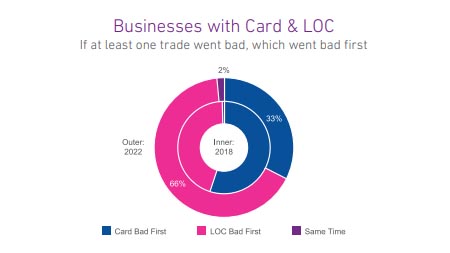
Since January 2021, a seasonally adjusted average of 444K new businesses opened each month, 52% higher than the pre-pandemic 2018-2019 monthly average. In light of the influx of new businesses, and in a higher-interest rate environment, the goal of this week’s analysis was to evaluate if commercial credit usage and payments by product shifted pre- and post-pandemic. Businesses with two different trade types were evaluated as of 2018 (prepandemic) and 2022 (post-pandemic). The two-trade-type combinations observed were Card + OECL (open ended credit line), Card +Term Loan, Card Lease, and Card + LOC (line of credit). Despite more younger businesses entering the market and lenders tightening credit policies over the past two years, businesses with two-trade types had higher lines/loans post-pandemic. Delinquencies also increased post-pandemic for all the two-trade type combinations except businesses with a Card & OECL. Commercial Cards are the most prevalent type of credit for businesses. As businesses grow, they seek additional credit for business needs such as expansion, new facilities, and acquisitions. When businesses seek additional credit, it is most often in the form of commercial loans, leases and credit lines which compared to cards, generally provide higher levels of funding, longer terms and higher monthly fixed payments. For businesses that had two types of accounts, including a commercial card with another commercial credit product, the commercial card stayed current longer and more often the non-card product went delinquent first. Businesses rely on commercial cards for day-to-day operating expenses and lower dollar financing needs. Furthermore, commercial card balances are significantly lower than any of the other commercial trade types allowing for a lower monthly minimum payment to keep the card in good standing. What I am watching: Federal Reserve Chairman Powell stated in last week’s Congressional hearings that the Fed will act slowly and cautiously in terms of cutting interest rates. With inflation declining but still persistent and the labor market still robust, rate cuts may not occur until the second half of the year. Download Report Download the latest version of the Commercial Pulse Report here. Better yet, subscribe so you'll get it in your inbox every time it releases, or once a month as you choose.

About the Main Street Report Experian and Oxford Economics have released the Q4 2023 Main Street Report. The report brings deep insight into the overall financial well-being of the small-business landscape, as well as providing commentary around what specific trends mean for credit grantors and the small-business community. Critical factors in the Main Street Report include a combination of business credit data (credit balances, delinquency rates, utilization rates, etc.) and macroeconomic information (employment rates, income, retail sales, industrial production, etc.). Q4 Report Highlights As we reflect on the journey of the American economy through the last quarter of 2023 and look ahead to 2024, it's clear that the resilience and adaptability of small businesses and consumers have been nothing short of remarkable. Despite facing challenges such as inflation and tighter lending conditions, the entrepreneurial spirit that defines Main Street has not only endured but is poised for growth. Unwavering Consumer Confidence Spurs Economic Optimism The U.S. economy, riding on the robustness of consumer spending, has once again demonstrated its strength. Consumers have outpaced holiday spending expectations, injecting vital liquidity into small businesses. This surge in spending has enabled these businesses to pay down debt and pivot towards capital expenditure and strategic growth planning for the coming year. The foundation of our economic optimism is solidified by the expected continuation of consumer support, bolstered by a strong labor market, and rising disposable incomes. Main Street Report Points to Easing Delinquency Among Small Businesses In the latest report, Oxford Economics anticipates an improved economic backdrop, along with a shift towards easier financing conditions, will keep the rise in corporate delinquencies muted and limit the normalization of bankruptcies over the coming year. Possibility of Changing Fed Policies Bodes Well for Innovation While headwinds such as inflation and cautious lending persist, the horizon is bright for small businesses. The Federal Reserve's anticipated policy adjustments, alongside a resilient consumer base, provide a green light for investment and growth. The adaptability and forward-thinking approach of small businesses will be crucial in harnessing these opportunities, driving not only their success but also contributing to the broader economic prosperity. Let It Grow As we stand on the threshold of 2024, the U.S. economy, powered by the dynamism of Main Street, is preparing to embark on a season of growth. The challenges of the past have paved the way for a future marked by resilience, innovation, and optimism. Small businesses, supported by a strong economic foundation and favorable policies, are set to lead the charge in driving forward the American dream. Download Your Copy of the Q4 2023 Main Street Report Today!

Get the latest quarterly small business credit trends Mark your calendars! Experian and Oxford Economics will discuss small business credit conditions when we present key findings in the latest Main Street Report for Q4 2023 during the Quarterly Business Credit Review. Michael Pearce, Oxford’s Lead U.S. Economist, will share his take on Experian’s most recent small business credit data and offer a macroeconomic outlook for the coming quarter. Brodie Oldham, Experian’s V.P. of Commercial Data Science, will cover commercial credit trends. Q4 2023 Main Street Report The Q4 2023 Experian/Oxford Economics Main Street report will be released on February 27th. If you are not already subscribed to thought leadership updates, be sure to sign up for updates on our Commercial Insights Hub.
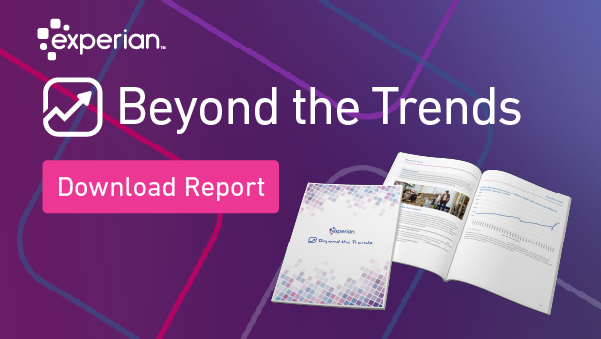
The Beyond the Trends report highlights indicators which offer insights on labor, prices, commercial credit and economic conditions.
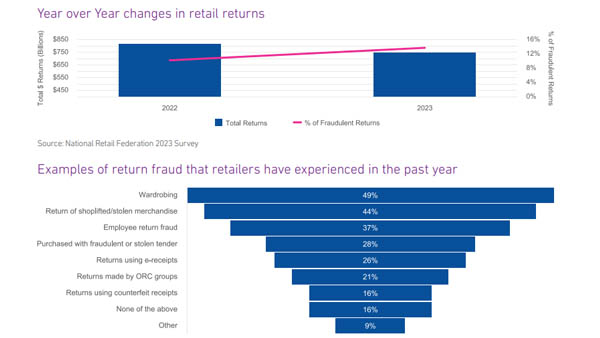
Retail sales reached a 4-year high of over $615B in December 2023 with yearly retail sales growing 4.6%. At the same time, lenders are tightening credit and businesses within the retail sector are showing signs of stress with higher late-stage delinquency rates and falling commercial credit scores. We see retailers seeking commercial credit less often, new originations slowing and lower lines over the past several months. As retail sales continue to rise so does the proportion of online retail sales. Online sales peaked during the COVID-19 pandemic and fell slightly once the lockdowns were lifted. Online retail sales remain approximately 56% higher than pre-pandemic levels and are trending up and may soon exceed 2020 levels. Growth in online retail sales has led to growth in retail returns. Retail returns peaked in 2022 at over $800MM and over 16% of total retail sales. Prior to 2021, retail returns as a percentage of retail sales averaged 8.9%, since 2021 that rate has grown to 14.6%. As returns increase so do fraudulent returns. Retailers have implemented strategies and solutions to address retail returns which resulted in a decrease in return dollars between 2022 and 2023 yet the percentage of returns that were fraudulent increased from 10.2% to 13.7% or over $100B. Increases in both legitimate and fraudulent returns are prompting retailers to identity solutions and operational strategies to slow growth across all returns. What I am watching: The U.S. economy expanded 3.3% in Q4 2023, and 2023 real GDP increased 2.5% over 2022. Strong consumer spending fueled the economy. Multiple sources are expecting The Federal Reserve to cut interest rates up to six times in 2024 with the rate cuts beginning in Q2 2024 and continuing into 2025. Lower interest rates likely means that consumer spending will continue at an elevated rate. As spending continues to increase, specifically in the retail sector, the need for commercial credit could continue to slow as cash-flows satisfy operational capital requirements. Cash on hand should begin to satisfy outstanding delinquencies, improving commercial credit scores resulting in improved access to commercial credit.
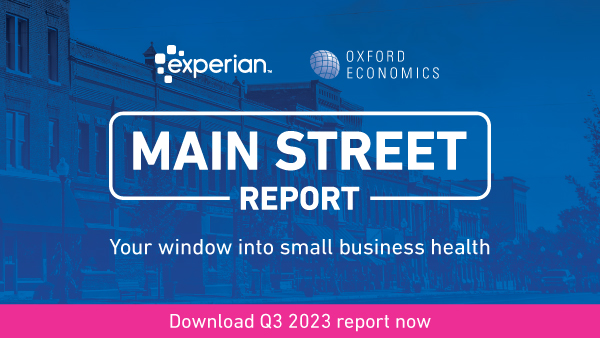
Experian and Oxford Economics Main Street Report for Q3 shows signs of slowdown despite strong Q3 expansion and changing credit conditions.

Get the latest quarterly small business credit trends Mark your calendars! Experian and Oxford Economics will discuss small business credit conditions when we present key findings in the latest Main Street Report for Q3 2023 during the Quarterly Business Credit Review. Michael Pearce, Oxford’s Lead U.S. Economist, will share his take on Experian’s most recent small business credit data and offer a macroeconomic outlook for the coming quarter. Brodie Oldham, Experian’s V.P. of Commercial Data Science, will cover commercial credit trends. Q3 2023 Main Street Report The Q3 2023 Experian/Oxford Economics Main Street report will be released on November 30th. If you are not already subscribed to thought leadership updates, be sure to sign up for updates on our Commercial Insights Hub.

New Report: Will the 2023 holiday season hinge on generosity? The latest Beyond the Trends report offers evidence it may.
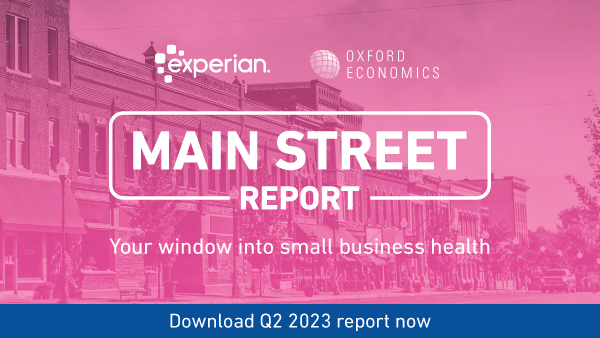
Recession fears may be calming, but several indicators are still flashing for 2024. Experian and Oxford Economics have released the Q2 2023 Main Street Report, the report brings deep insight into the overall financial well-being of the small-business landscape, as well as provides commentary around what specific trends mean for credit grantors and the small-business community. Report Summary During Q2, lenders adjusted underwriting criteria to limit exposure as delinquencies remained elevated for consumers and small businesses. The markets dealt with inflation above target and customers reevaluated their discretionary spending and growth investment strategies. Not all segments of the markets were impacted by environmental forces. Technology-focused companies are leading investment and growth, while logistic, utility, and healthcare struggle, Supply chain disruptions are smoothing, but lighter forecasted demand is already impacting inventory reorders. The softer demand is hitting trucking and logistic companies hard as tonnage, and mileage are lighter than forecasted as consumers return to the in-person experience and engage with eroded purchasing power. The bright spot is consumer resiliency. This prolonged spending strength is fueled by a tight labor market, wage growth, and relief in energy and food costs.Another element is savings. Dwindling savings, increased reliance on unsecured debt to support spending behavior, reassumption of monthly debt servicing obligations (student loan payments), and prolonged inflation place downward pressure on the consumer. Recession fears may be calming, but several indicators are still flashing for 2024. Download Q2 2023 Main Street Report
